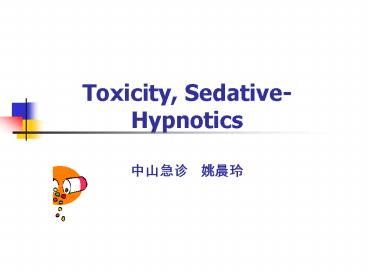Toxicity, Sedative-Hypnotics ???? ??? PowerPoint PPT Presentation
1 / 26
Title: Toxicity, Sedative-Hypnotics ???? ???
1
Toxicity, Sedative-Hypnotics ???? ???
2
Background
- Sedative-hypnotics are a group of drugs that
cause CNS depression. - Benzodiazepines (BZD)
- barbiturates
- nonbarbiturate nonbenzodiazepine
sedative-hypnotics (NBNB)
the most commonly used agents
3
Background
- acute sedative-hypnotics poisoning
- withdrawal syndrome
4
Etiology
- Benzodiazepines (BZD)
- Long acting (half life gt30h)
- chlordiazepoxide (???)
- diazepam(??????)
- flurazepam (???)
- Short acting (half life 6-30h)
- alprazolam(????)
- Ultrashort acting
- triazolam(???)
5
Etiology
- Barbiturates
- Ultrashort acting
- Methohexital (Brevital??????)
- thiopental (Pentothal????)
- Short acting
- pentobarbital (Nembutal????)
- secobarbital (Seconal?????)
- Intermediate acting
- Amobarbital (Amytal?????)
- butalbital (Fioricet, Fiorinal?????)
- Long acting
- Phenobarbital (Luminal???)
6
Etiology
- Nonbarbiturate, nonbenzodiazepine
sedative-hypnotics (NBNB) - Chloral hydrate (????)
- Ethchlorvynol (????)
- Glutethimide (???)
- Methyprylon (????)
- Meprobamate (???)
7
Pathogenesis
- ??Pharmacokinetics
- 1?Pharmacokinetics of the BZD
- Most BZD are extensively metabolized by the
liver. - Some are metabolized to products which are
active - and may have a much longer half life than the
parent - drug.
- The major route of metabolism is
N-demethylation. - in the elderly
- Cimetidine
8
Pathogenesis
- 2?Pharmacokinetics of Barbiturates
- Barbiturates with low lipid solubility are
excreted in the unchanged form by the kidneys. ie
phenobarbital(????). - Barbiturates with high lipid solubility are
metabolized to more polar compounds in the liver
before being excreted via the kidneys. ie
thiopental (???).
9
Pathogenesis
- 3?Pharmacokinetics of NBNB
- Most NBNB are extensively metabolized by the
liver
10
Pathogenesis
?? The mechanism of action
- BZD
- In the CNS, benzodiazepines exert their
clinical effect by enhancing the activity of the
inhibitory neurotransmitter GABA. - (The clinical effects of GABA release and
GABA-gated chloride channels include sleep
induction and excitement inhibition) - Barbiturates
- in prolongation of the duration of opening of
GABA-gated chloride channels, leading to
hyperpolarization of the membrane and suppression
of neurotransmission. ? - NBNB
- similar to the action of Barbiturates
11
Cl-
Cl-
---
--
hyperpolarization
BZD
GABA
chloride channel
12
Clinical
- Benzodiazepine
- blurred vision, dizziness, confusion,
drowsiness, anxiety, agitation, and
unresponsiveness or coma. - BZD overdose in itself is remarkably safe. most
patients with benzodiazepine overdose can be
managed in the ED and released home after
appropriate care. - When combined with other sedatives (most
frequently alcohol), patients with benzodiazepine
overdose can present with profoundly depressed
levels of consciousness. .
13
Clinical
- Barbiturates
- Mild intoxication is characterized by ataxia,
incoordination, nystagmus, slurred speech, and
altered level of consciousness. - Moderate poisoning leads to respiratory
depression and hyporeflexia. - Severe poisoning leads to flaccid areflexic coma,
apnea, and hypotension. - Occasionally, hyperreflexia, rigidity, clonus,
and Babinski signs are present. - Miosis is common, but mydriasis may be present
with certain agents. - Generally, 10 times the hypnotic dose
produces severe toxicity.
14
Clinical
- Chloral hydrate
- Mild intoxication is characterized by ataxia,
lethargy - Severe poisoning leads to stupor, coma, pinpoint
pupils, hypotension, slow or rapid and shallow
respiration, hypothermia, areflexia, and muscle
flaccidity. - Arrhythmias
15
Clinical
- Glutethimide (Doriden)
- Loss of brainstem reflexes
- Flaccidity
- Anticholinergic effects
- Delayed gastric emptying
- May cause hyperthermia or heatstroke
16
Clinical
- Methaqualone (Quaalude)
- Resembles barbiturate poisoning
- Has more pronounced motor problems (eg, ataxia)
and is known as wallbanger because of this
phenomenon. - Can lead to severe muscular hypertonicity and
seizures
17
Lab Studies
- Obtain a complete blood count (CBC), arterial
blood gas (ABG), glucose, chemistry, - Imaging Studies
- Obtain an abdominal x-ray. Chloral hydrate is
radiopaque. - Other Tests
- Obtain an electrocardiogram (ECG) Co-ingested
drugs may have direct cardiac effects (eg,
tricyclic antidepressants).
18
Lab Studies
- Quantitative serum drug concentrations are
recommended for patients with serious toxicity - Barbiturates For short-acting drugs, the lethal
dose is 3 g or a serum concentration higher than
3.5 mg/dL. For long-acting drugs, the lethal dose
is 5-10 g or a concentration higher than 8 mg/dL. - Chloral hydrate The lethal dose is 10 g and a
concentration higher than 100 mg/mL is toxic
19
Diagnosis
- History
- Symptom and sign
- serum drug concentrations
20
Differentials
- Toxicity, Alcohols
- Hypoglycemia
- Diabetic Ketoacidosis
- Neoplasms, Brain
21
Treatment
- Emergency Department Care
- Establish ABCs, obtain IV access, provide oxygen
- Ensure adequate airway and ventilation. Do
endotracheal intubation if necessary. - Fluid resuscitation and anti-shock
- Naloxone is recommended to the patients with
comma.
22
Treatment
- Prevention of absorption
- Gastric lavage may be performed if the patient
presents obtunded within 2hour of ingestion - Activated charcoal is recommended for
sedative-hypnotic overdoses. Multi-dose activated
charcoal (20-50 g q4h) is recommended for
overdoses with barbiturates, glutethimide, and
meprobamate.
23
Treatment
- Elimination enhancement
- Alkaline diuresis enhances elimination of
phenobarbital and other long-acting barbiturates.
It is recommended for all symptomatic patients
with long-acting barbiturate toxicity. - Consider hemodialysis or hemoperfusion in
glutethimide, methyprylon, phenobarbital,
meprobamate, and chloral hydrate poisoning.
24
Treatment
- Detoxicant Flumazenil
- Flumazenil competitively and reversibly binds
benzodiazepine receptors (ie, GABA). - The use of flumazenil for suspected
benzodiazepine overdoses is controversial. If
used, it should be administered slowly (0.2
mg/min up to 3-5 mg) because large doses cause
agitation and withdrawal. - This drug is contraindicated in patients with
increased intracranial pressure (ICP) or closed
head injury (CHI), those with a history of
epilepsy, or those known to have ingested a
tricyclic antidepressant (TCA) agent
25
Treatment of complication
- Pneumonia
- Arrhythmias
- Acute renal failure
26
Prognosis prophylaxis

